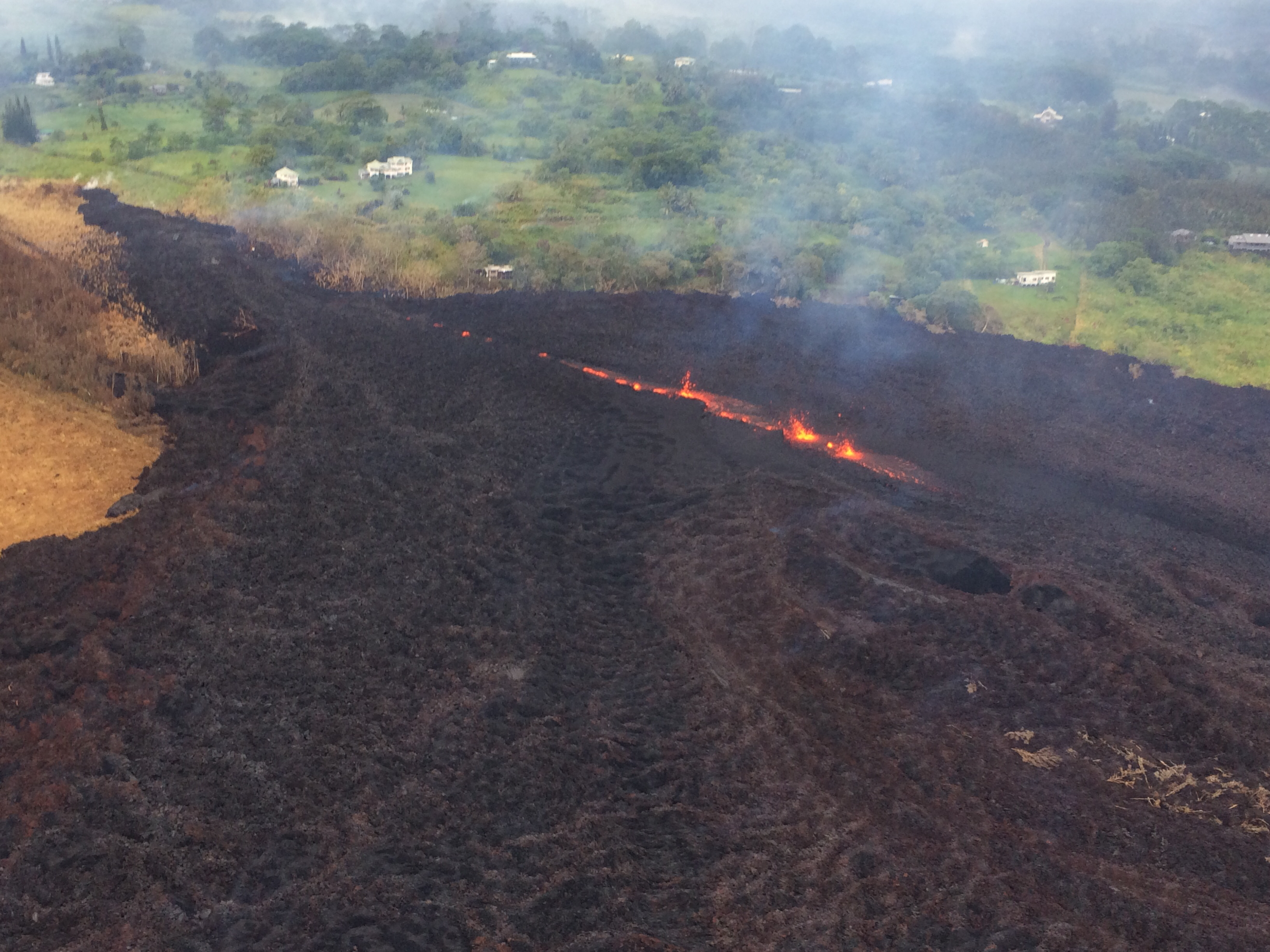Hawaiian Volcano Observatory: Beware of Spurious Reports

Fissure 17 as seen from the air on Monday, May 17, around 7 a.m. HST, when the overall vigor of fissure appeared to have dropped from the previous two days. Twenty-two fissures have erupted in the lower Puna District on the Island of Hawaiʻi as of May 18, and additional fissures could still open as this eruption on Kīlauea Volcano’s East Rift Zone continues. USGS photo.
False rumors about the ongoing volcanic activity at the summit and lower East Rift Zone of Kīlauea Volcano are causing unnecessary anxiety and confusion, according to the USGS’s Hawaiian Volcano Observatory.
“We encourage everyone to check the source of any information you read or hear to be sure that it’s factual, accurate, and timely,” HVO scientists stated in their latest activity update.
“Particularly disturbing are individuals who take a kernel of truth (for example, data from vetted scientific papers), twist it into a lump of misinformation, and then present a skewed view of that data as fact. Please beware of spurious reports, and don’t believe everything you read on social media—unless it’s posted by a known and trusted source,” agency officials said.
So, where can you get the straight facts about what’s currently happening on Kīlauea? Here are some reliable sources of information:
The USGS Hawaiian Volcano Observatory website, where you can find daily eruption updates, photos, videos, webcams, and maps. In addition to the daily updates, Status Reports, Information Statements, and Volcano Activity Notices are posted as warranted.
If you prefer to receive HVO’s updates and other notices automatically via email, check out the USGS Volcano Notification Service.
If you don’t have access to the website, you can call (808) 967-8862 to hear a recorded summary update for Kīlauea.
Back to HVO’s website, there’s a new tab labeled “2018 Activity” in the menu at the top of the homepage. Click that tab to open a list of numerous resources related to the current summit and East Rift Zone volcanic activity.
Also, take a look at the “HVO News” section in the lower left corner of HVO’s homepage. There, you will find information that dispels some of the more egregious rumors. For example, check out the news item that provides facts about the stability of Kīlauea’s south flank and addresses the possibility of a flank collapse and tsunami. There’s also a report about explosion hazards at the summit of Kīlauea, as well as a timeline of Kīlauea events since late April 2018.
Other US Geological Survey websites are also great resources. The USGS Volcanic Ash Impacts and Mitigation website provides a wealth of information about what to do and how to protect yourself, buildings, plants, and animals if you are in the path of falling ash.
Interest in HVO’s website has skyrocketed. With nearly continuous seismic activity at Kīlauea’s summit and lower East Rift Zone, HVO’s earthquake page has been overwhelmed at times. If/when that happens, you can still get Hawai‘i earthquake information through the USGS National Earthquake Information Center. Scroll across the NEIC map until you see Hawai‘i, then zoom in. Change the settings to your preference, and you’ll be able to track earthquake activity across the island.
Many readers are likely familiar with the Hawaiʻi Interagency Vog Information Dashboard, which provides comprehensive information about vog (volcanic air pollution). Note that two new links have been added to this website to address ash hazards from the Kīlauea summit explosions and the ongoing eruption on Kīlauea’s lower East Rift Zone.
Residents and visitors can receive timely notifications about emergency situations in the County of Hawai‘i, including the current volcanic activity, through the Civil Defense Emergency Notification System.
As volcanic activity at Kīlauea’s summit and East Rift Zone continues, the public is encouraged to stay informed through trusted sources and to help your friends and family get the straight facts. Also, please be safe out there—heed all warnings and stay out of closed areas.
Volcano Activity Updates
On Kilauea Volcano’s East Rift Zone, low-level eruption of lava continues from multiple points along the active fissure system. Residents in the lower Puna District of Hawaiʻi Island should remain informed and heed Hawaiʻi County Civil Defense closures, warnings, and messages. At Kῑlauea’s summit, an explosion, or series of explosions, from the Overlook vent within Halemaʻumaʻu crater on May 17, produced a volcanic cloud that reached as high as 30,000 feet above sea level. The cloud drifted generally northeast and traces of ash fell in areas around Kῑlauea’s summit. Summit activity could again become more explosive, increasing the intensity of ash production and producing ballistic projectiles close to the vent. Communities downwind should be prepared for ashfall as long as this activity continues.
Mauna Loa is not erupting. Rates of deformation and seismicity have not changed significantly over the past week. The number of monthly and weekly earthquakes recorded beneath the volcano has decreased to near background levels.
Twenty earthquakes were reported felt in Hawaii during the past week. Some were aftershocks associated with the magnitude-6.9 earthquake on May 4, but many others were related to continued deflation at Kīlauea’s summit and with the ongoing intrusion of magma into the volcano’s East Rift Zone. Additional felt earthquakes should be expected in the coming days to weeks.
Please visit HVO’s website for past Volcano Watch articles, Kīlauea daily eruption updates, Mauna Loa weekly updates, volcano photos, maps, recent earthquake info, and more. Call for summary updates at 808-967-8862 (Kīlauea) or 808-967-8866 (Mauna Loa). Email questions to [email protected].
*Volcano Watch is a weekly article and activity update written by U.S. Geological Survey Hawaiian Volcano Observatory scientists and affiliates.










